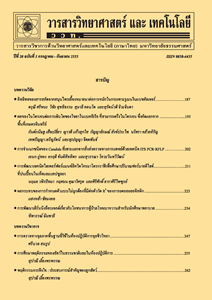ฤทธิ์ยับยั้งเอนไซม์แอลฟาอะไมเลสและฤทธิ์ต้านออกซิเดชันของสารสกัดหยาบจากผลมะเดื่ออุทุมพรด้วยเอทานอล
Main Article Content
Abstract
Abstract
Diabetes mellitus (DM) is a metabolic disorder which can lead to chronic hyperglycemia. Diabetes impairs blood vessels and increases the risk of chronic kidney disease, vision loss and heart attack. The increase of free radical production is commonly related to these complications. Inhibition of carbohydrate hydrolyzing enzymes such as a-amylase, in the gastrointestinal tract can be an effective strategy to slow down dietary carbohydrate digestion and also reduce postprandial hyperglycemia. The objectives of this study were to investigate the a-amylase inhibition activity of Ficus racemosa Linn. fruit ethanolic extract (FRFE) and to determine its antioxidant capacity. The extract was determined for a-amylase inhibitory effect by 3,5 dinitrosalicylic (DNS) method, and for antioxidant potentials by radical scavenging capacity assay (2,2-diphenyl-1-picrylhydrazyl, DPPH) and 2,2’-azinobis (3-ethylbenzothiazoline-6-sulfonic acid, ABTS), and ferric ion reducing power assay (FRAP). In DNS method, the highest inhibitory effect of the extract against a-amylase was 84.02±3.17 % at 20 µg/mL with the IC50 value of 7.44±0.23 µg/mL. In DPPH and ABTS assays, FRFE had IC50 value of 128.84±52.89 µg/mL and 30.21±2.42 µg/mL, respectively. In FRAP assay, FRFE had FRAP value of 0.58±0.03 mM Fe2+/mg dried extract weight. In conclusion, FRFE demonstrated an a-amylase inhibitory activity and antioxidant potentials. However, this study suggests that it would be further investigated, especially active the therapeutically ingredients of this extract as well as clinical study to develop a novel anti-diabetic drug.
Keywords: fruit of Ficus racemose; alpha-amylase; antioxidant
Article Details
References
[2] Ullah, A., Khan, A. and Khan, I., 2016, Diabetes mellitus and oxidative stress: A concise review, Saudi. Pharm. J. 24: 547-553.
[3] Giacco, F. and Brownlee, M., 2010, Oxidative stress and diabetic complica tions, Circ. Res. 107: 1058-1070.
[4] Standl, E. and Schnell, O., 2012, Alpha-glucosidase inhibitors 2012 – cardiovas cular considerations and trial evaluation, Diab. Vasc. Dis. Res. 9: 163-169.
[5] Kim, K., Rioux, L. and Turgeon, S.L., 2014, Alpha-amylase and alpha-glucosidase inhibition is differentially modulated by fucoidan obtained from Fucus vesiculosus and Ascophyllum nodosum, Phytochemis try 98: 27-33.
[6] Nutmakul, T., Pattanapanyasat, K., Soonthornchareonnon, N., Shiomi, K., Mori, M. and Prathanturarug, S., 2016, Anti plasmodial activities of a Thai traditional antipyretic formulation, Bencha-Loga-Wichian: A comparative study between the roots and their substitutes, the stems, J. Ethnopharmacol. 193: 125-132.
[7] คณะกรรมการพัฒนาระบบยาแห่งชาติ เรื่องบัญชียาจากสมุนไพร แนบท้ายประกาศบัญชียาหลักแห่งชาติ พ.ศ. 2559, ประกาศในราชกิจจานุเบกษา เล่ม 133 ตอนพิเศษ 86 ง., หน้า 11 , ลงวันที่ 12 เมษายน 2559.
[8] Veerapur, V.P., Prabhakar, K.R., Thippeswamy, B.S., Bansal, P., Srinivasan, K.K. and Unnikrishnan, M.K., 2012, Antidiabetic effect of Ficus racemosa Linn. stem bark in high-fat diet and low-dose streptozotocin-induced type 2 diabetic rats: A mechanistic study, Food Chem. 132: 186-193.
[9] Jain, R., Rawat, S. and Jain, S.C., 2013, Phytochemicals and antioxidant evalua tion of Ficus racemosa root bark, J. Pharm. Res. 6: 615-619.
[10] Joseph, B. and Raj, S.J., 2010, Phyto pharmacological and phytochemical properties of three Ficus species – an overview, Int. J. Pharma. Bio. Sci. 1: 246-253.
[11] ภัทรา พวงช่อ, นาฏศจี นวลแก้ว, 2556, ฤทธิ์ยับยั้งเอนไซม์แอลฟากลูโคซิเดสของสารสกัดพื้นบ้าน, ว.เภสัชศาสตร์อีสาน 9(1): 218.
[12] Ali, H. and Houghton, P.J., 2006, Soumyanath A. -Amylase inhibitory activity of some Malaysian plants used to treat diabetes, with particular reference to Phyllanthus amarus, J. Ethnopharmacol. 107: 449-455.
[13] Blois, M.S., 1958, Antioxidant determina tions by the use of a stable free radical, Nature 4617: 1199-1200.
[14] Re, R., Pellegrini, N., Proteggente, A., Pannala, A., Yang, M. and Rice-Evans, C., 1999, Antioxidant activity applying an improved ABTS radical cation decolorization assay, Free Radic. Biol. Med. 26: 1231-1237.
[15] Benzie, F.F. and Strain, J.J., 1996, The ferric reducing ability of plasma (FRAP) as a measure of: “Antioxidant Power”: The FRAP assay, Anal. Biochem. 239: 70-76.
[16] Hasan, N., Shirin, F., Khan, A.J., Mamun, A., Belal, H., Hasan, M., Islam, A., Tasnin, N., Karim, R.U., Asaduzzaman, Islam, D., Ara, T., Rahman, K.Z., Rahman, M. and Islam, M.A., 2017, Hypoglycemic, Hypolipidemic and Antibacterial Activity of Ficus racemosa Fruit Extract, Br. J. Pharm. Res. 16(1): 1-9.
[17] Zulfiker, A.H.M., Saha, M.R., Sarwar, S., Nahar, L., Hamid, K. and Rana, M.S., 2011, Hypoglycemic and in vitro antioxidant activity of ethanolic extracts of Ficus racemose Linn. Fruits, Am. J. Sci. Ind. Res. 2, 391-400.
[18] Amin, M., Bhakta, S. and Das, S.K., 2015, Anti-diabetic potential of Ficus racemosa: Current state and prospect especially in the developing countries, J. Biosci. Agric. Res. 5: 65-72.
[19] Deepa, P., Sowndhararajan, K., Kim, S. and Park, S.J., 2018, A role of Ficus species in the management of diabetes mellitus: A review, J. Ethnopharmacol. 215: 210-232.
[20] Rathinavelusamy, P., Mazumder, P.M., Sasmal, D. and Jayaprakash, V., 2014, Evaluation of in silico, in vitro -amylase inhibition potential and antidiabetic activity of Pterospermum acerifo lium bark, Pharm. Biol. 52: 199-207.
[21] Sumi, S.A., Siraj, A., Hossain, A., Mia, S., Afrin, S. and Rahman, M., 2016, Investigation of the key pharmacological activities of Ficus racemosa and analysis of its major bioactive polyphenols by HPLC-DAD, Evid. Based Complement. Alternat. Med. 2016: 1-9.
[22] Ramana, G., Reddya, C.S., Raob, CV., 2011, In-vitro and in-vivo anti-oxidant activity of Ficus racemosa Linn. fruit extract and Aegle marmelos root and leaf extracts, J. Pharm. Res. 4: 2078-2081.
[23] Veerapur, V.P., Prabhakar, K.R., Parihar, V.K., Kandadi, M.R., Ramakrishana, S., Mishra, B., Mishra, B., Satish Rao, B.S., Srinivasan, K.K., Priyadarsini, K.I. and Unnikrishnan, M.K., 2009, Ficus racemosa stem bark extract: A potent antioxidant and a probable natural radioprotector, Evid. Based Complement. Alternat. Med. 6: 317-324.
[24] Deshmukh, T.A., Yadav, B.V., Badole, S.L., Bodhankar, S.L. and Dhaneshwar, S.R., 2007, Antihyperglycaemic activity of petroleum ether extract of Ficus racemose fruits in alloxan induced diabetic mice, Pharmacol. Online 2: 504-515.


